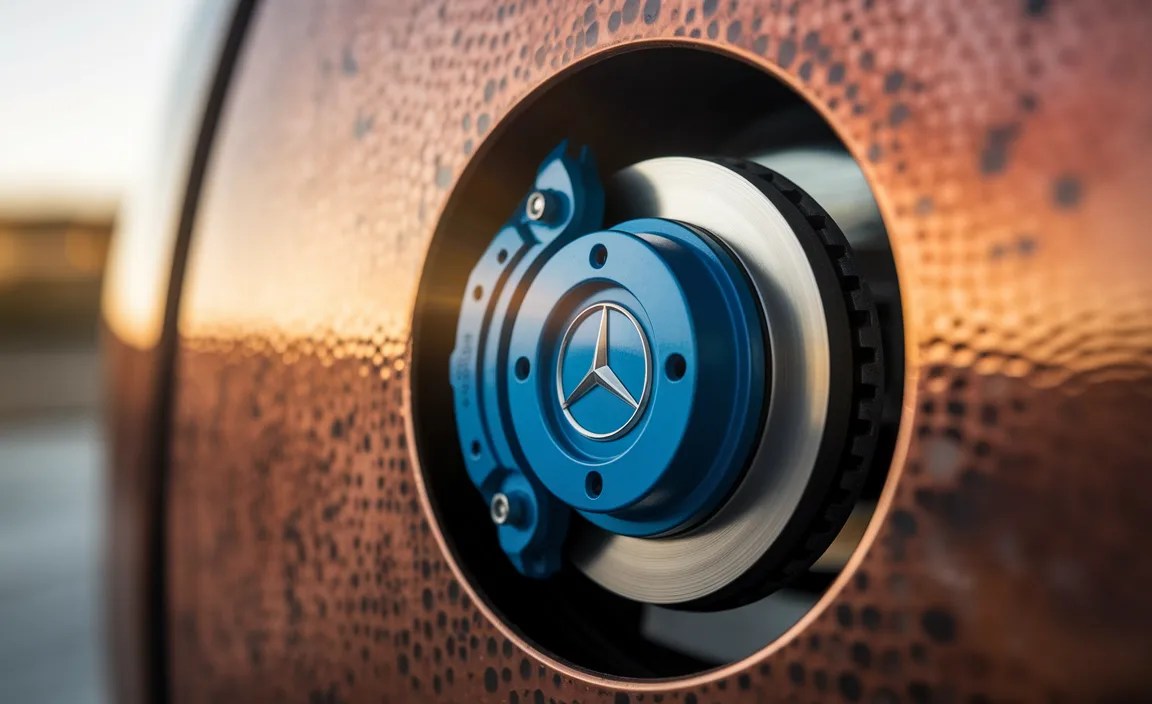Mercedes-Benz C Class Brake Pads: Ultimate Performance, Perfect Stop
Your Mercedes C-Class brake pads are crucial for safety and performance. Replacing them ensures optimal stopping power, a quieter ride, and protects your braking system. This guide will help you understand when and how to choose the perfect C-Class brake pads for ultimate performance and a perfect stop.
When your beloved Mercedes-Benz C-Class signals it’s time for new brake pads, it’s more than just a routine maintenance task. It’s about preserving the legendary driving dynamics and, most importantly, ensuring your safety on the road. Worn brake pads can lead to reduced stopping power, increased braking distances, and potential damage to more expensive braking components like rotors.
Don’t worry; understanding your C-Class brake pads and how to select the right ones is straightforward. We’ll guide you through everything you need to know, from recognizing the signs of wear to making an informed choice for ultimate performance and that perfect, confident stop.

Recognizing the Signs Your C-Class Needs New Brake Pads
Your C-Class is designed to communicate its needs, and the braking system is no exception. Paying attention to subtle (and not-so-subtle) changes is key to proactive maintenance. Ignoring these signs can compromise safety and lead to costlier repairs down the line.

Auditory Warnings: What That Squealing Means
The most common indicator is a high-pitched squealing or grinding sound when you apply the brakes. This noise often comes from the brake wear indicators, small metal tabs designed to make contact with the rotor when the pads reach a critical thickness. Ignoring this sound is like ignoring a smoke alarm – it’s a clear warning that demands attention.
Tactile Feedback Through the Pedal
You might feel a pulsating or vibrating sensation through the brake pedal when you press it. This can indicate warped brake rotors, which often go hand-in-hand with worn brake pads. It can also be a sign of uneven pad material transfer. In some cases, you might notice the brake pedal feels softer or travels further than usual, suggesting air in the brake lines or severely worn pads.
Visual Inspection: Your First Line of Defense
Whenever possible, visually inspect your brake pads. You can usually see them through the spokes of your C-Class wheels. Look at the thickness of the friction material (the part that contacts the rotor). If it’s less than about 3-4 millimeters (roughly the thickness of two to three credit cards), it’s time for a replacement.
Performance Degradation
If you notice that your C-Class is taking longer to stop than it used to, or if your braking feels less responsive, this is a critical sign. This can be due to glazed pads, contaminated pads, or simply pads that have worn beyond their effective limit.
Understanding C-Class Brake Pad Types for Optimal Performance
Not all brake pads are created equal, and the type you choose will significantly impact your C-Class’s braking performance, noise levels, and even wheel cleanliness. For a Mercedes-Benz, especially a C-Class, choosing the right pad material is a balance of daily drivability and performance feel.

Organic Pads: Quiet Comfort
Also known as Non-Asbestos Organic (NAO) pads, these are typically the standard OEM (Original Equipment Manufacturer) pads found on many luxury vehicles.
- Pros: Extremely quiet operation, gentle on rotors, low dust production, and generally the most affordable option.
- Cons: Tend to wear out faster, especially under aggressive driving conditions. They offer less initial bite and fade resistance compared to other types.
- Best For: Drivers who prioritize a quiet, comfortable ride and do mostly city driving or relaxed highway cruising.
Semi-Metallic Pads: The Versatile Choice
These pads are a popular aftermarket upgrade and offer a good balance of performance and everyday usability. They consist of a blend of metal fibers (like steel, copper, or iron) mixed with fillers.
- Pros: Excellent heat dissipation, good stopping power across a wide temperature range, durable, and often provide better initial bite than organic pads.
- Cons: Can be noisier than organic pads, produce more dust (often black and gritty, sticking to wheels), and can wear rotors slightly faster.
- Best For: Most C-Class drivers looking for an upgrade over standard organic pads, offering improved performance and durability for varied driving conditions.
Ceramic Pads: Clean Performance
Ceramic brake pads are made from a composite material containing ceramic fibers, non-ferrous metals, and bonding agents. They are known for their clean operation and consistent performance.
- Pros: Very low dust production (often light-colored and easily washed off), quiet operation, excellent performance across a wide temperature range, and long pad life. They are also less abrasive on rotors.
- Cons: Can be more expensive than organic or semi-metallic pads. Some drivers report a slightly less aggressive initial “bite” compared to aggressive semi-metallics, though this varies greatly by manufacturer.
- Best For: Drivers who value clean wheels, quiet operation, and consistent performance without the harshness sometimes associated with semi-metallic pads. Ideal for daily driving with occasional spirited moments.
Performance or High-Performance Pads
These are generally aggressive semi-metallic or specialized composite pads designed for track use or extremely spirited driving.
- Pros: Superior stopping power, exceptional fade resistance at high temperatures, and aggressive initial bite.
- Cons: Very noisy, produce significant dust, can be harsh on rotors, and may require higher operating temperatures to perform optimally. Not ideal for everyday street use.
- Best For: Track-focused C-Class models or drivers who participate in autocross or track days.
Choosing the Right Pads for Your C-Class Model
Your specific C-Class model, including its year and any performance packages (like AMG sport packages), plays a role in selecting the ideal brake pads.

Standard C-Class Models (C200, C250, C300)
For daily driving, commuting, and comfortable highway cruising, either high-quality OEM-style organic pads or reputable ceramic pads are usually the best choice. They offer the quietness and low dust expected from a luxury sedan.
Sport and AMG Line Models
If your C-Class has the sport suspension or AMG styling package, it likely comes with larger brakes and is tuned for a more engaging driving experience. In this case, premium semi-metallic or performance-oriented ceramic pads can enhance the braking feel and capability without compromising too much on daily comfort.
AMG Models (C43, C63, etc.)
AMG models are built for performance. While standard replacement pads can work, consider high-performance or track-focused pads if you drive your AMG aggressively or participate in track events. However, for daily street use, a high-grade ceramic or a more refined semi-metallic compound from a performance brand will offer a noticeable improvement in feel and durability over standard pads, while being livable for daily driving.
The Brake Rotor Connection: It’s Not Just Pads
Brake pads work in conjunction with brake rotors (or discs). When replacing pads, it’s essential to consider the condition of your rotors.
Rotor Condition Matters
Grooves and Scoring: Deep grooves or scoring on the rotor surface indicate wear and can reduce braking effectiveness.
Warping: A warped rotor will cause pulsation in the brake pedal and steering wheel.
Thickness: Rotors have a minimum thickness specification. If they are too thin, they must be replaced.
Resurfacing vs. Replacement
Often, minor imperfections can be addressed by resurfacing (or “machining”) the rotors. This removes a thin layer of material to create a flat, smooth surface. However, if rotors are significantly worn, grooved, warped, or below minimum thickness, replacement is necessary.
Choosing Rotors to Match Your Pads
Standard Replacement Rotors: Suitable for organic and most ceramic pads for daily driving.
Performance Rotors: Often feature slotted or cross-drilled designs.
Slotted Rotors: Help sweep away dust and gas, potentially improving wet weather performance and pad cleaning.
Cross-Drilled Rotors: Designed to dissipate heat more effectively and prevent glazing, often used in high-performance applications. However, they can be more prone to cracking under extreme thermal stress and may increase pad wear.
High-Carbon Content Rotors: Offer better thermal stability and less prone to warping under heavy use.
For most C-Class owners, using high-quality OEM-style or performance-oriented blank rotors is the ideal pairing for premium ceramic or semi-metallic pads. For AMG owners pushing the limits, slotted or drilled rotors might offer benefits, but always consider the trade-offs.
DIY or Professional? Replacing C-Class Brake Pads
Replacing brake pads is a common DIY task for many car owners. However, for a Mercedes-Benz C-Class, precision and the right tools are paramount.
The DIY Approach: What You Need
If you’re comfortable working on your vehicle, here’s what you’ll generally need:
New Brake Pads: Ensure they are for your specific C-Class model and year.
New Brake Rotors (if needed): Ensure proper fitment.
Jack and Jack Stands: For safely lifting and supporting the vehicle. Refer to your C-Class owner’s manual for proper jacking points. NHTSA provides excellent safety guidelines for vehicle lifts and stands.
Lug Wrench or Torque Wrench: To remove and properly tighten wheel lug nuts.
Socket Set and Wrenches: For caliper bolts.
C-Clamp or Brake Piston Compressor Tool: To retract the caliper piston.
Brake Cleaner: To clean components.
Brake Lubricant/Grease: High-temperature, silicone-based grease for caliper pins and pad backing plates.
Gloves and Safety Glasses: For protection.
Wire Brush: To clean rust and debris from the caliper bracket and hub.
Disclaimer for DIY Enthusiasts
Working on brakes requires attention to detail. Improper installation can lead to brake failure. If you are unsure about any step, consult your C-Class service manual or seek professional help. Mercedes-Benz vehicles often have specific procedures and torque specifications that are critical for safety. Always refer to the official Mercedes-Benz service information for your model.
Professional Replacement: Peace of Mind
For many owners, especially those new to Mercedes-Benz or less experienced with DIY repairs, professional replacement is the recommended route.
- Expertise: Certified technicians understand the intricate systems of your C-Class.
- Specialized Tools: They have access to specific Mercedes-Benz diagnostic tools and equipment.
- Warranty: Reputable shops offer warranties on parts and labor, providing peace of mind.
- Correct Torque Specs: Crucial for safety and component longevity.
The Brake Pad Replacement Process (Step-by-Step)
Here’s a simplified overview of the process. Remember, always consult your specific C-Class service manual for detailed instructions and torque specifications.

Step 1: Prepare and Secure the Vehicle
- Park your C-Class on a level surface.
- Engage the parking brake (if replacing rear pads, this may need to be disengaged or bypassed depending on the system).
- Loosen the lug nuts on the wheel you’ll be working on, but don’t remove them yet.
- Using your jack, lift the vehicle at the designated jacking point and support it securely with jack stands. Never work under a vehicle supported only by a jack.
- Remove the lug nuts and the wheel.
Step 2: Remove the Caliper
- Locate the brake caliper bolts (usually two on the back of the caliper).
- Remove the caliper bolts using the appropriate socket or wrench.
- Carefully slide the caliper off the rotor. If it’s stuck, a gentle tap with a rubber mallet might help.
- Do not let the caliper hang by the brake hose. Suspend it using a piece of wire or bungee cord from the suspension.
- Remove the old brake pads from the caliper bracket. They may slide out or require some gentle persuasion.
Step 3: Compress the Caliper Piston
- Before installing new, thicker pads, you need to push the caliper piston(s) back into their bore.
- Using a C-clamp or a brake piston compressor tool, slowly and steadily push the piston back until it is flush with the caliper housing. Watch the brake fluid reservoir under the hood; it may overflow if it’s full. Remove some fluid if necessary, but do not let the reservoir run dry.
Step 4: Inspect and Prep the Rotor and Hardware
- Inspect the brake rotor for signs of wear (grooves, warping, minimum thickness). If replacement or resurfacing is needed, do this now.
- Use a wire brush to clean any rust or debris from the caliper bracket where the pads sit.
- Inspect the caliper guide pins. If they are sticky or dry, remove them, clean them, and re-lubricate them with high-temperature brake grease.
Step 5: Install New Brake Pads
- Apply a thin layer of brake lubricant to the back of the new brake pads (where they contact the caliper piston and bracket) and the edges/ears of the pad. Do not get lubricant on the friction material. Some pads come with new hardware (shims, clips) – install these if provided.
- Slide the new brake pads into the caliper bracket, ensuring they sit flush and properly.
Step 6: Reinstall the Caliper
- Carefully place the caliper back over the new pads and rotor.
- Reinstall the caliper bolts and tighten them to the manufacturer’s specified torque. This is critical for safety. Brake hardware specifications are vital for proper function and safety.
Step 7: Reinstall Wheel and Lower Vehicle
- Reinstall the wheel and thread on the lug nuts by hand.
- Lower the vehicle off the jack stands.
- Tighten the lug nuts using a torque wrench to the manufacturer’s specification in a star pattern.
Step 8: Bed-In the New Pads
This is a crucial step to ensure optimal performance and longevity of your new pads and rotors.
What is Bedding-In?
Bedding-in (or “burnishing”) transfers a thin, even layer of pad material onto the rotor surface. This ensures optimal friction and prevents glazing.






